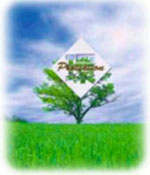

The Art Clay series
of products are made of pure metal powders mixed with non-toxic binders and
water. The Art Clay product range is easy to handle, and you can freely shape
it just like with the modeling clay you used when you were a child. When Art
Clay Silver is taken out of the package, it is a slightly moist lump of clay.
The clay is composed of 1-20 micron sized metal particles, organic binders, and
water . The clay is then molded into its desired generic shape, and dried. Once
the clay is completely dry it can then be filed, carved, and sanded; after
which it is fired with a gas stovetop, butane torch, or kiln. After firing at
the proper temperature and holding time you will get a one-of-a-kind pure
(99.9%) silver, gold (22K), or copper (99.5%) piece . During the firing
process, the organic binders burn away and the resulting silver particles
"sinter",
becoming denser and stronger. The burning away of binders and sintering of
metal causes the piece to shrink 8-10% in overall size while retaining the
original form. Once completely fired, the remaining piece is able to be
finished quickly and easily for the perfect amount of desired shine. Fired
pieces can also be enameled, patinated, or soldered to.

|
Clay Form

Clay contains fine silver powder, water, and binder. Can be formed while still soft.
|

|
Drying

Moisture in the clay dries out, and the clay gets harder.
|

|
First stage of Firing

Binder burns away, and fine silver powder starts the sintering process.
|

|
Completely fired

Silver particles solidify completely, and become more than 99.9% pure silver.
|
|

Forming
|

|

Trimming Drying
|

|

Firing
|

|

Finishing
|

Examples of the three different firing methods: 
What is the difference between Sterling Silver and Pure Silver?
Sterling Silver is composed of 92.5% silver and 7.5% of one or more other metals. A common misconception is that copper always makes up the remainder, when in reality titanium, platinum, palladium, and a list of other metals are often used. The addition of another metal to the silver creates an alloy. Sterling Silver is stronger than Pure Silver, and as an alloy, it tarnishes more quickly as well. Pure Silver is composed of 99.9% silver and nothing else.
Is Art Clay safe to use?
Yes, all of Art Clay’s products are non–toxic, and most carry the ACMI "AP" seal.
The manufacturer of Art Clay, Aida Chemical Industries, Co., Ltd. is a member of the Art & Creative Materials Institute. The Art & Creative Materials Institute, Inc. is an international association composed of a diverse and involved membership, and is recognized as the leading authority on art and creative materials. ACMI's members are art and creative materials manufacturers, and currently there are over 210 members.
Since its inception, ACMI’s certification program has certified that products in the program are either non-toxic or appropriately labeled with any cautionary language and safe use instructions. Of the 60,000 art materials in the program, 100% of the children's products and 85% of those meant for the adult artist are certified as non-toxic. This certification program has received the endorsement of experts in the field of toxicology and is one of the finest industry programs in existence. ACMI seeks to create and maintain a positive environment for art and creative materials usage; to promote safety in art and creative materials; and to serve as an information and service resource on art and creative materials.
What do the ACMI Seals mean?
The AP (Approved Product) Seal, with or without Performance Certification, identifies art materials that are safe and that are certified in a toxicological evaluation by a medical expert to contain no materials in sufficient quantities to be toxic or injurious to humans, including children, or to cause acute or chronic health problems. Additionally, products bearing the AP Seal with Performance Certification or the CP Seal are certified to meet specific requirements of material, workmanship, working qualities, and color developed by ACMI and others through recognized standards organizations, such as the American National Standards Institute (ANSI) and the American Society for Testing and Materials (ASTM).
Who makes Art Clay?

Art Clay is manufactured in Japan by Aida Chemical Industries. Aida Chemical Industries is a family owned company that recycles and reclaims metals, including the precious metals gold and silver. In 1991 Aida Research and Development obtained a patent for the manufacturing process for a metal clay, which became Art Clay. The clay, paste and syringe types were introduced to Japan in late 1992. The Aida Planning Department began to develop the books and other accompanying materials and, in April, 1994, Art Clay Silver and Gold were officially introduced into the general public in Japan. Art Clay World, USA is the North American distributor of Art Clay, and you can click here for a list of links to other worldwide distributors.
Aida Chemical Industries is a "green" company. It collects metals which already have been used and reclaims these metals. Such items as computer circuit boards and silver from photographic supplies are processed in tremendous quantities every year. A portion of this harvest becomes Art Clay Silver and Art Clay Gold.
Aida combines these reclaimed metals with non-toxic, organic binders. The result is a product which can be handled safely. Every effort has been made to assure the safety of artists using Art Clay. Even the production processes used to create Art Clay are designed to have minimal effects on the environment.



![]()




















